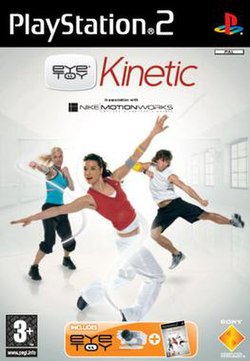
Calisthenics or callisthenics (/ˌkælɪsˈθɛnɪks/) is a form of strength training that utilizes an individuals body weight as resistance to perform multi-joint, compound movements with little or no equipment.

Aerobic exercise is physical exercise of low to high intensity that depends primarily on the aerobic energy-generating process. "Aerobic" is defined as "relating to, involving, or requiring oxygen", and refers to the use of oxygen to meet energy demands during exercise via aerobic metabolism adequately. Aerobic exercise is performed by repeating sequences of light-to-moderate intensity activities for extended periods of time. Examples of cardiovascular or aerobic exercise are medium- to long-distance running or jogging, swimming, cycling, stair climbing and walking.

Physical fitness is a state of health and well-being and, more specifically, the ability to perform aspects of sports, occupations and daily activities. Physical fitness is generally achieved through proper nutrition, moderate-vigorous physical exercise, and sufficient rest along with a formal recovery plan.

Sega Superstars is a party video game developed by Sonic Team for the PlayStation 2. It was published by Sega and released in Europe on October 22, 2004; in North America in November 2, 2004; and in Japan in November 11, 2004. The game features several minigames based on various Sega titles that are controlled using the EyeToy peripheral. Upon release, the game received "average" review scores from critics.

Strength training, also known as weight training or resistance training, involves the performance of physical exercises that are designed to improve strength and endurance. It is often associated with the lifting of weights. It can also incorporate a variety of training techniques such as bodyweight exercises, isometrics, and plyometrics.
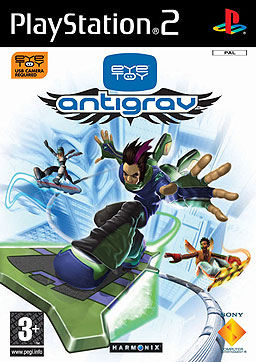
EyeToy: AntiGrav is a hoverboard game by Harmonix, released in November 2004 for the PlayStation 2. It was touted as the first "real" game for EyeToy targeted to more seasoned gamers. The earlier games such as Play and Groove were geared towards younger players for family or party fun. Unlike the earlier EyeToy games, the player's image is not shown inside the Antigrav game. Instead, the player's movement is reflected in the animated character in the game. The player moves their body to guide the on-screen character through a track. Some obstacles require the player to crouch or jump. Up to 4 players are supported. The game was released in the U.S. in November 2004, and in PAL in March 2005.
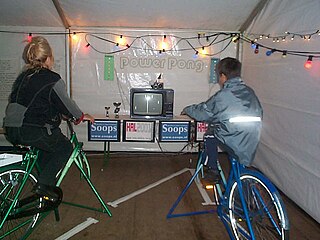
Fitness game, exergame, and gamercise are terms used for video games that are also a form of exercise. Fitness games rely on technology that tracks body movement or reaction. The genre has been used to challenge the stereotype of gaming as a sedentary activity, and promoting an active lifestyle. Fitness games are seen as evolving from technology aimed at making exercise more fun.

EyeToy: Play 2 is the second PlayStation 2 game in the EyeToy: Play series. It uses EyeToy camera technology to project the player on to the television screen, allowing them to interact with on screen objects. The game contains twelve new minigames, that allow for single or multiplayer modes. The game also introduces a tournament mode, that allows several players to compete in a series of minigames, earning points for each game won.

EyeToy: Play 3 is the third game in the EyeToy: Play series, for up to four players. The camera takes snapshots during the game for your player and is a requirement to play the game. Unlike previous EyeToy: Play games, Play 3 was not released in North America. Unlike the previous games, 4 players were able to play on screen at the same time as opposed to taking it in turns like the previous games.

Yourself!Fitness is an exercise video game, developed by Respondesign. It was published first for the Xbox, and later for PlayStation 2 and Microsoft Windows. Through a publishing deal with Ubisoft, Yourself!Fitness was ported to and released on the Wii in December 2008 under the name My Fitness Coach.

CrossFit is a branded fitness regimen that involves constantly varied functional movements performed at high intensity. The method was developed by Greg Glassman, who founded CrossFit with Lauren Jenai in 2000, with CrossFit its registered trademark. The company forms what has been described as the biggest fitness chain in the world, with around 12,000 affiliated gyms in over 150 countries as of 2022, under half of which are located in the United States.

Wii Fit is a 2007 exergaming video game designed by Nintendo's Hiroshi Matsunaga for the Wii home video game console, featuring a variety of yoga, strength training, aerobics, and balance mini-games for use with the Wii Balance Board peripheral. Matsunaga described the game as a "way to help get families exercising together". It has since been adopted by various health clubs around the world, and has previously been used for physiotherapy rehabilitation in children and in nursing homes to improve posture in the elderly.
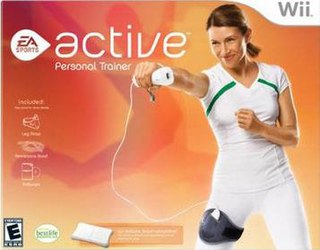
EA Sports Active: Personal Trainer is a video game developed by EA Canada for the Wii console. It was released on May 19, 2009 in North America. The game ships with a strappable pouch to hold the Nunchuk and a resistance band.
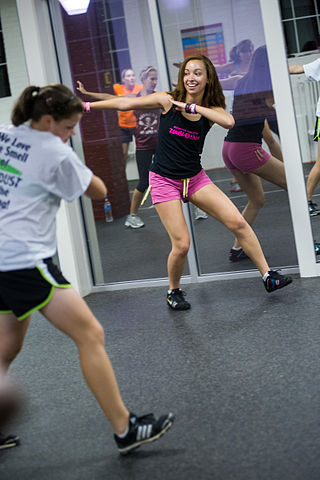
Zumba is a fitness program that involves cardio and Latin-inspired dance. It was founded by Colombian dancer and choreographer Beto Pérez in 2001, It currently has 200,000 locations, with 15 million people taking classes weekly, and is located in 180 countries. Zumba is a trademark owned by Zumba Fitness, LLC.

Brian Sterling-Vete is an English author, Guinness World Record Holder, motivational speaker, TV broadcaster, Director, Stage, Film and Television actor, stunt performer, martial arts expert, fitness expert and entrepreneur.

UFC Personal Trainer: The Ultimate Fitness System is a fighting and fitness video game created by THQ. The game requires the Kinect accessory for the Xbox 360 version and the PlayStation Move and PlayStation Eye Camera for the PlayStation 3 version. The Wii version does not require any additional accessories to play.
Street workouts are a physical activity performed in outdoor parks or public facilities. The movement behind street workouts became popular in Russia, Israel, Myanmar, Morocco, Eastern Europe, and the United States, especially in New York City, Los Angeles, Chicago, Philadelphia, Miami, Baltimore, Washington, D.C., and other urban East Coast neighborhoods. It is a combination of athletics, calisthenics, and sports. "Street workout" is a modern name for calisthenics in outdoor parks. There are also street workout teams and organized competitions for exercises such as pull-ups, chin-ups, push-ups, dips, rows, muscle-ups, sit-ups and squats. A street workout also involves static (isometric) holds such as the human flag, front lever, back lever, L-sit and planche.
Michael Gonzalez-Wallace is a fitness guru best known for developing the Brain Body Fitness Program called Super Body, Super Brain.

Xbox Fitness was a service for the Xbox One console, developed by Microsoft Studios in partnership with Sumo Digital, which featured fitness and exercise videos from trainers Jillian Michaels, Tracy Anderson, Tony Horton of P90X and Shaun T of Insanity. Xbox Fitness was one of the 22 game titles that launched with Xbox One. The game used the Kinect sensor to track the player's heart rate and estimated calories burned, and gave feedback about how well the player is performing the exercise activities.

Orangetheory Fitness (OTF) is an American boutique fitness studio franchise based in Boca Raton, Florida. The first studio was established in Fort Lauderdale, Florida in 2010 by founder, Ellen Latham. The classes are one hour long and involve two groups, one on the treadmills and the other group working with weights or on rowers. As of 2023, Orangetheory Fitness has over 1,500 studios throughout 50 US states and 24 countries. Since its founding in 2010, the chain has expanded, surpassing $1 billion in systemwide sales in 2018. As of 2020, the chain has over one million members.
